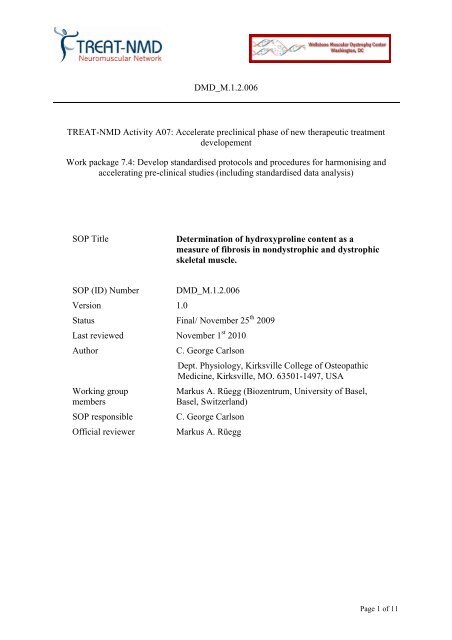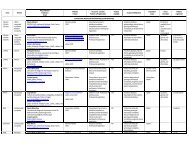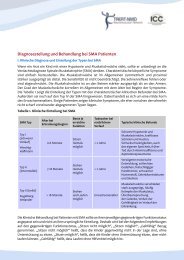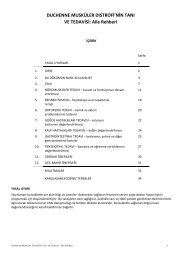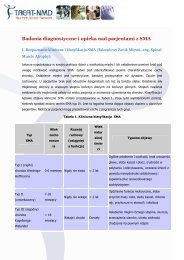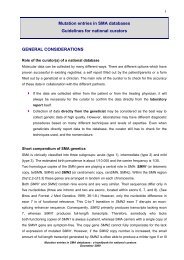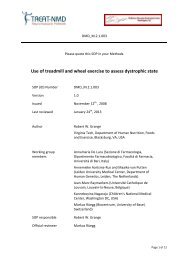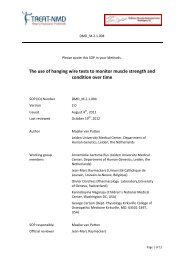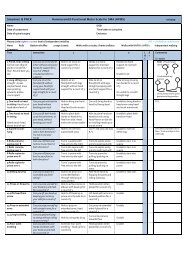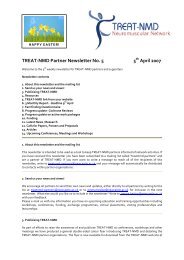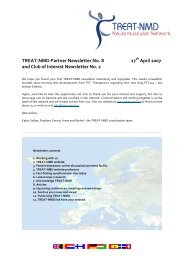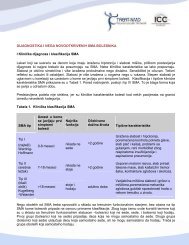Hydroxyproline assay - Treat-NMD
Hydroxyproline assay - Treat-NMD
Hydroxyproline assay - Treat-NMD
Create successful ePaper yourself
Turn your PDF publications into a flip-book with our unique Google optimized e-Paper software.
DMD_M.1.2.006<br />
TREAT-<strong>NMD</strong> Activity A07: Accelerate preclinical phase of new therapeutic treatment<br />
developement<br />
Work package 7.4: Develop standardised protocols and procedures for harmonising and<br />
accelerating pre-clinical studies (including standardised data analysis)<br />
SOP Title<br />
Determination of hydroxyproline content as a<br />
measure of fibrosis in nondystrophic and dystrophic<br />
skeletal muscle.<br />
SOP (ID) Number<br />
Version 1.0<br />
DMD_M.1.2.006<br />
Status Final/ November 25 th 2009<br />
Last reviewed November 1 st 2010<br />
Author<br />
Working group<br />
members<br />
SOP responsible<br />
Official reviewer<br />
C. George Carlson<br />
Dept. Physiology, Kirksville College of Osteopathic<br />
Medicine, Kirksville, MO. 63501-1497, USA<br />
Markus A. Rüegg (Biozentrum, University of Basel,<br />
Basel, Switzerland)<br />
C. George Carlson<br />
Markus A. Rüegg<br />
Page 1 of 11
DMD_M.1.2.006<br />
TABLE OF CONTENTS<br />
OBJECTIVE.............................................................................................................................. 3<br />
SCOPE AND APPLICABILITY .............................................................................................. 3<br />
CAUTIONS............................................................................................................................... 4<br />
MATERIALS ............................................................................................................................ 5<br />
METHODS................................................................................................................................ 6<br />
EVALUATION AND INTERPRETATION OF RESULTS.................................................... 9<br />
REFERENCES........................................................................................................................ 11<br />
Page 2 of 11
DMD_M.1.2.006<br />
1 OBJECTIVE<br />
The objective is to determine the total hydroxyproline expressed per mg of muscle<br />
tissue wet weight (hydroxyproline content) as a quantitative measure of collagen deposition<br />
and fibrosis. The procedure is adapted from Prockop and Udenfriend (1960) and Switzer and<br />
Summer (1971). Briefly, individual muscles are weighed before being acid-hydrolyzed at<br />
130°C for 12 hours in 5N HCl (10 mg muscle wet weight/ml). Samples of the hydrolysate<br />
equivalent to 0.5 mg of muscle (50 µl) are diluted with 2.25 ml of distilled water and<br />
neutralized with appropriate amounts of 0.1N KOH (phenolphthalein indicator). Sodium<br />
borate buffer (0.5 ml, pH 8.7) is then added and the mixture is oxidized with 2.0 ml of 0.2 M<br />
chloramine-T solution. After a brief incubation (25 minutes), the oxidation reaction is stopped<br />
by adding 1.2 ml of 3.6 M sodium thiosulfate. Since the pyrroline and pyrrole carboxylic<br />
oxidation products that are formed from hydroxyproline are not soluble in toluene,<br />
contaminating impurities are extracted by adding 2.5 ml toluene and saturating amounts of<br />
KCl (1.5 g). After appropriate mixing of the toluene and aqueous phases, the phases are<br />
separated by centrifugation (300 to 400g for 1 minute). The toluene phase containing the<br />
extracted impurities is then removed and discarded. The remaining aqueous layer containing<br />
the hydroxyproline products is heated for 30 minutes in boiling water to convert the oxidation<br />
product of hydroxyproline, pyrrole-2-carboxylic acid, to pyrrole. The final pyrrole reaction<br />
product is then removed in a second toluene extraction, and 1.5 ml of the final toluene layer is<br />
mixed with 0.6 ml Ehrlich’s reagent for colorimetric <strong>assay</strong> against hydroxyproline standards<br />
(0.0, 0.5, 1.0, 2.0, 4.0 6.0 µg hydroxyproline) at 560 nm. <strong>Hydroxyproline</strong> contents of<br />
individual muscles are expressed as µg hydroxyproline/mg muscle wet weight.<br />
2 SCOPE AND APPLICABILITY<br />
The method provides a quantitative scalar determination of the total amount of<br />
hydroxyproline per mg muscle wet weight. The technique was first used to assess the<br />
hydroxyproline levels in the mdx diaphragm (Stedman et al., 1991) and provides a simple and<br />
relatively rapid quantitative determination that can be used to assess efficacy in reducing<br />
fibrosis in dystrophic muscle.<br />
Under some circumstances, this protocol for determining hydroxyproline content<br />
should be complemented by independent histological determinations of fibrosis using a<br />
trichrome staining technique (or suitable alternative) and point counting measures to assess<br />
the proportion and distribution of fibrotic tissue within muscle cross sections. For example, in<br />
some cases a particular drug or treatment may not alter the total hydroxyproline expressed per<br />
mg of muscle, but may nevertheless alter the distribution of collagen within the muscle. In<br />
such cases, point-counting procedures for assessing the proportion of collagen in muscle<br />
cross-sections and morphometric evaluation of the density and area of collagenous fibrotic<br />
plaques provide an independent measure to exclude the possibility that a treatment alters<br />
collagen distribution without altering total collagen expression.<br />
Page 3 of 11
DMD_M.1.2.006<br />
3 CAUTIONS<br />
Age, Muscle, and Gender Considerations. Since collagen levels increase with age in skeletal<br />
muscle from both nondystrophic and dystrophic mice, it is imperative that comparisons be<br />
made only between groups that are appropriately age-matched. Collagen levels also differ<br />
between different muscles in both nondystrophic and mdx mice. It is therefore quite important<br />
to identify the muscle being evaluated. Experiments comparing hydroxyproline contents in<br />
adult gastrocnemius and costal diaphragm muscle indicate that hydroxyproline content is not<br />
significantly elevated over nondystrophic levels in the gastrocnemius, but is quite<br />
substantially elevated in the costal diaphragm (Graham et al., 200X; Fig. 2). These results and<br />
those of Stedman et al (1991) clearly identify the costal diaphragm as the most appropriate<br />
muscle to use when examining the potential efficacy of experimental treatments to reduce<br />
fibrosis in the mdx mouse. We have not observed obvious gender differences in<br />
hydroxyproline content in either nondystrophic or mdx mice.<br />
Purity of muscle sample. In determining hydroxyproline content, it is essential that only<br />
muscle tissue be used, and that all tendinous material be carefully removed from the sample<br />
before performing the <strong>assay</strong>. A good sample would be obtained by using approximately ½ of<br />
an entire costal hemidiaphragm. The muscle should be flash-frozen and may be stored at -80 O<br />
C for several weeks before running the <strong>assay</strong>. In practice, samples are usually run within<br />
about 4 weeks of the time that they are isolated.<br />
Critical steps in the hydroxyproline <strong>assay</strong>. There are some particularly important steps in the<br />
hydroxyproline <strong>assay</strong> that must be monitored carefully to ensure quality results.<br />
(Steps 2A and B).The first two steps in the hydrolysis (step 2A, B in Methods)<br />
of the muscle tissue involve overnight incubation of the sample in 5 N HCl at 130 ° C. The acid<br />
solution must be contained within stoppered glass tubes that do not leak. Therefore, the<br />
volume of acid in each tube should be visually monitored before and after the incubation<br />
period to ensure it remains constant throughout the incubation period. Instances in which<br />
there is a clear loss of volume indicate a gas leak and should result in termination of the<br />
experiment for that sample. To avoid this problem, use brand new screw-tops and make sure<br />
that the screw tops are tightly applied to each tube prior to the incubation.<br />
(Step 4N). In removing the toluene layer containing the final pyrrole reaction<br />
product, it is imperative not to disturb or remove any of the aqueous layer. If aqueous solution<br />
is removed, it clouds the colorimetric reaction measured in step 5. To avoid this problem,<br />
remove only 1.5 ml of the 2.5 ml toluene layer and make the appropriate correction to<br />
determine the hydroxyproline level in the 2.5 ml of toluene extract (Evaluation and<br />
Interpretation of Results).<br />
Continuity of <strong>assay</strong>. Theoretically, once the muscle sample is fully hydrolyzed (Step 2c), it<br />
may remain at room temperature for up to 3 to 4 hours before processing the sample (Step 4).<br />
Once the processing steps have begun (Step 4A), they should continue without interruption<br />
until the <strong>assay</strong> has been completed (Step 5). In practice, it takes about 5 hours to fully process<br />
about 30 test tubes and the process is facilitated by having more than one investigator engaged<br />
in Steps 4 and 5.<br />
Page 4 of 11
DMD_M.1.2.006<br />
Precautions. Standard protection (gloves, eye protection, lab coat) should be used at all times<br />
when handling acids and toluene solutions. Toluene extractions should be performed under a<br />
fume hood. All solutions at the end of the procedure should be discarded using<br />
environmentally-appropriate procedures for handling acids and organic solvents.<br />
4 MATERIALS<br />
1) Stock Buffer Composition:<br />
50 g citric acid monohydrate (Sigma #C7129)<br />
12 ml glacial acetic acid (Sigma #A6283)<br />
120 g sodium acetate trihydrate (Sigma #S7670)<br />
34 g NaOH<br />
Total volume in ddH 2 O (dd means double distilled or filtered and distilled) = 1 liter<br />
Measure 900 ml ddH 2 O and add 12 ml glacial acetic acid slowly while mixing. Add<br />
citric acid monohydrate, sodium acetate trihydrate, and NaOH. Add ddH 2 O to total<br />
volume of 990 ml and adjust pH to 6.0 with HCl and NaOH as needed. Add ddH 2 O to<br />
total volume of 1 liter and check pH again. Label (HP Stock Buffer solution, pH,<br />
initials, date) and store in refrigerator.<br />
2) Ehrlich’s Reagent (from Prockop and Udenfriend, 1960; for step 4P):<br />
Slowly mix 27.4 ml of concentrated sulfuric acid to 200 ml of absolute alcohol in a<br />
500 ml beaker.<br />
In another beaker, add 120 g of p-dimethylaminobenzaldehyde to 200 ml of absolute<br />
alcohol.<br />
Slowly mix the two solutions in the first beaker.<br />
Store the final solution in the refrigerator, and allow crystals to come out of the<br />
solution before using.<br />
Other chemicals needed:<br />
Phenolphthalein solution (1%)<br />
0.8 N and 0.1N KOH<br />
0.1 M sodium borate buffer (pH 8.7)<br />
0.2 M chloramine-T<br />
3.6 M sodium thiosulfate<br />
KCl<br />
Toluene<br />
Page 5 of 11
Instruments needed for measurements:<br />
DMD_M.1.2.006<br />
Glass test tubes (15 ml capacity) with screw caps<br />
Oven<br />
Spectrometer<br />
Tabletop centrifuge<br />
Tabletop test tube Invertor<br />
Tabletop vortexor<br />
5 METHODS<br />
1) Tissue preparation<br />
Blot and weigh fresh or thawed muscle sample (e.g. ½ to 1 costal hemidiaphragm) to<br />
obtain wet weight. Make sure that the muscle sample is carefully trimmed and contains no<br />
tendinous material.<br />
2) Hydrolysis. Always wear appropriate protection (lab coat, heavy rubber gloves, eye<br />
protection) and use standard safety procedures when handling acids.<br />
A. Add 5N HCl (1ml HCl /10mg tissue) to the muscle sample in glass test tube. Tighten<br />
screw-tops carefully and ensure that the screw-tops are not over-worn from previous<br />
use.<br />
B. Incubate tubes at 130 o C for 12 hrs (setting is number 13 on the Fisher Scientific<br />
Isotemp oven).<br />
C. Remove muscle samples from oven and cool to room temperature. Do not open the<br />
test tubes until they are cooled to room temperature.<br />
3) Prepare chemicals and solutions<br />
A. Determine how many tubes (n) will be run. This includes all the experimental<br />
samples (in triplicate) and the hydroxyproline standards (in duplicate) plus the blank<br />
tube.<br />
B. Weigh approximately 1.5 g of KCl for each test tube and place in weigh boats (see<br />
step 4G).<br />
C. Prepare chloramine T solution (for step 4E):<br />
1) Determine the total volume of chloramine T solution that will be needed.<br />
This is equal to 2n +2 in ml (extra 2 ml for making sure there is enough volume).<br />
Page 6 of 11
DMD_M.1.2.006<br />
2) Weigh out enough chloramine T for the total volume that is required. Based<br />
on the molecular weight of chloramine T (Sigma # C9887; 227.6 g/mole):<br />
(2n +2) ml x 0.2 moles/1000 ml x 227.6 g/mole = Amount Chloramine<br />
T needed in g.<br />
Example: for 10 tubes to be run:<br />
(20 +2) ml x 0.2 moles/1000ml x 227.6 g/mole = 1.00 g chloramine T<br />
3) Dissolve chloramine T in the appropriate volume of buffer:<br />
a.) Prepare the following volumes:<br />
Volume of Stock Buffer (see Materials) = 0.5*(2n +2)<br />
Volume of ddH 2 O = 0.2*(2n+2)<br />
Volume of methylcellosolve (2 methoxyethanol; Sigma<br />
#284467) = 0.3*(2n+2)<br />
b.) Instructions for preparing solution:<br />
Add the appropriate volume of ddH 2 O to the amount of<br />
chloramine T determined in step C2, and then the appropriate volumes of the<br />
stock buffer and methyl cellosolve. Mix thoroughly.<br />
4) Sample and standard processing. To ensure safety, all of the following steps should be<br />
conducted using a fume hood and standard laboratory safety precautions required for<br />
handling acids and organic solvents.<br />
A. Make sure hydrolyzed muscle sample at room temperature is mixed well (invert<br />
closed tube to mix). Remove 50 µl of the hydrolyzed muscle sample, which represents<br />
0.5 mg of the original muscle wet weight, and add to 2.25 ml of ddH 2 O (need total<br />
volume of 2.3 ml) in glass test tube. Repeat in triplicate for each muscle sample. In a<br />
test tube marked “0” (blank), add 2.3 ml ddH 2 O. Screw a cap on each test tube.<br />
B. Set up the hydroxyproline standards in 2.3 ml of ddH 2 O (run each in duplicate)<br />
containing, for example, 0.75, 1.5, 3.0, and 6.0 µg of hydroxyproline. A 1mg/ml stock<br />
solution of hydroxyproline (in ddH 2 O) may be stored in the freezer. Screw a cap on<br />
each test tube.<br />
C. Add 1 drop of phenolphthalein solution (1%) to each tube and adjust pH to a “faint<br />
pink color” with 0.1 N KOH (Using a Pasteur pipette, add about 5 drops of 0.8 N<br />
KOH then add drops of 0.1N KOH until faint pink).<br />
D. Add 0.5 ml of 0.1 M sodium borate buffer (pH 8.7) to each tube, screw a cap on each<br />
tube, and mix by vortexing at low speed.<br />
Page 7 of 11
DMD_M.1.2.006<br />
E. Add 2.0 ml of freshly prepared 0.2 M chloramine-T solution to each tube, screw a cap<br />
on each tube, and incubate at room temperature for 25 minutes.<br />
F. Add 1.2 ml of 3.6 M sodium thiosulfate to each tube, screw a cap on each tube, and<br />
mix thoroughly (vortex) for 10 sec.<br />
G. Add 1.5 g KCl and 2.5 ml toluene to each tube. Screw a cap on each tube.<br />
H. Shake sample for 5 minutes or slowly invert test tubes 100 times, preferably using a<br />
test tube invertor.<br />
I. Centrifuge at approximately 300-400 g (1 minute) to separate layers.<br />
J. Remove toluene phase using clean Pasteur micropipette. Discard using appropriate<br />
procedures for organic solvents.<br />
K. Heat remaining aqueous phase in boiling water for 30 minutes (cap tightly).<br />
L. Cool to room temperature.<br />
M. Add 2.5 ml toluene to each tube, screw a cap on each tube, and repeat steps 4H-I.<br />
N. Remove 1.5 ml of toluene layer and place in a separate test tube. Screw a cap on each<br />
tube.<br />
O. Gently warm stock Ehrlich’s reagent (see Materials) that is kept in refrigerator in order<br />
to remove crystals.<br />
P. Add 0.6 ml Ehrlich’s reagent, mixing well to prevent layering of the solvent. Incubate<br />
at room temperature for 30 minutes.<br />
5) Measure samples<br />
Using a conventional glass or quartz cuvette, measure the blank-corrected (sample – blank)<br />
absorbance (560 nm) for each solution obtained in step 4P.<br />
Page 8 of 11
DMD_M.1.2.006<br />
6 EVALUATION AND INTERPRETATION OF RESULTS<br />
A. Perform a linear regression analysis of the results using the hydroxyproline standards to<br />
identify the relationship between hydroxyproline (µg) and Absorbance (e.g., Fig. 1).<br />
Absorbances (560 µm)<br />
0.4<br />
0.3<br />
0.2<br />
0.1<br />
y = -0.00921 + 0.0572 x<br />
R = 0.997<br />
Figure 1. Example of a<br />
hydroxyproline standard curve<br />
and the least squares<br />
determination of the standard<br />
curve equation relating<br />
hydroxyproline (µg) to<br />
Absorbance. Inset shows the<br />
results of regression analyses.<br />
0.0<br />
0 1 2 3 4 5 6 7<br />
<strong>Hydroxyproline</strong> (µg)<br />
B. Determine the amount of hydroxyproline (µg) in each sample test tube (Step 4P) using the<br />
regression curve from the hydroxyproline standards. In the example shown (Fig. 1), the<br />
appropriate relationship is:<br />
Sample <strong>Hydroxyproline</strong> (µg) = (Sample Absorbance + 0.00921)/0.0572<br />
C. Since the amount of hydroxyproline in the final colorimetric reaction (Step 4P) represents a<br />
proportion (1.5 ml/2.5 ml) of the total hydroxyproline in the final toluene extract (Step 4M),<br />
multiply the result obtained in Step 6B by (2.5/1.5) to obtain the total amount of<br />
hydroxyproline present in the final extract.<br />
D. Divide the result obtained in Step 6C by the amount of muscle (wet weight) contained in<br />
the initial sample (0.5 mg; Step 4A) to obtain the hydroxyproline content (µg<br />
hydroxyproline/mg muscle). Examples of typical values obtained from the costal diaphragms<br />
of 14 month old nondystrophic and mdx mice are shown (Fig. 2).<br />
Page 9 of 11
DMD_M.1.2.006<br />
<strong>Hydroxyproline</strong> Content (µg/mg)<br />
25<br />
20<br />
15<br />
10<br />
5<br />
0<br />
N = 5<br />
Nondystrophic<br />
N = 6<br />
**<br />
MDX<br />
Figure 2. <strong>Hydroxyproline</strong> Contents (µg<br />
hydroxyproline/mg muscle) determined from<br />
the costal diaphragms of 14 month<br />
nondystrophic (gray histobar) and mdx (gray<br />
hatched histobar) mice. N is the number of<br />
preparations (mice). Shown are the means<br />
and standard errors. ** indicates p< 0.01<br />
between mean nondystrophic and mdx<br />
values.<br />
Page 10 of 11
DMD_M.1.2.006<br />
7 REFERENCES<br />
Graham KM, Singh R, Millman G, Malnassy G, Gatti F, Berge J, Bruemmer K, Stefanski C,<br />
Curtis H, Sesti J, and Carlson CG. Inhibitors of the NF-κB pathway do not influence collagen<br />
deposition in dystrophic (mdx) muscle, submitted, 200X<br />
Prockop D.J. and Udenfriend S., (1960). A specific method for the analysis of hydroxyproline<br />
in tissues and urine. Analytical Biochemistry, 1, 228-239.<br />
Stedman, H.H., Sweeney, H.L., Shrager, J.B., Maguire, H.C., Panettieri, R.A., Petrof, B.,<br />
Narusawa, M., Leferovich, J.M., Sladky, J.T., Kelly, A.M., (1991). The mdx mouse<br />
diaphragm reproduces the degenerative changes of Duchenne muscular dystrophy. Nature<br />
352, 536-539.<br />
Switzer, B.R., Summer, G.K., (1971). Improved method for hydroxyproline analysis in tissue<br />
hydrolyzates. Anal Biochem. 39(2), 487-491.<br />
Page 11 of 11


